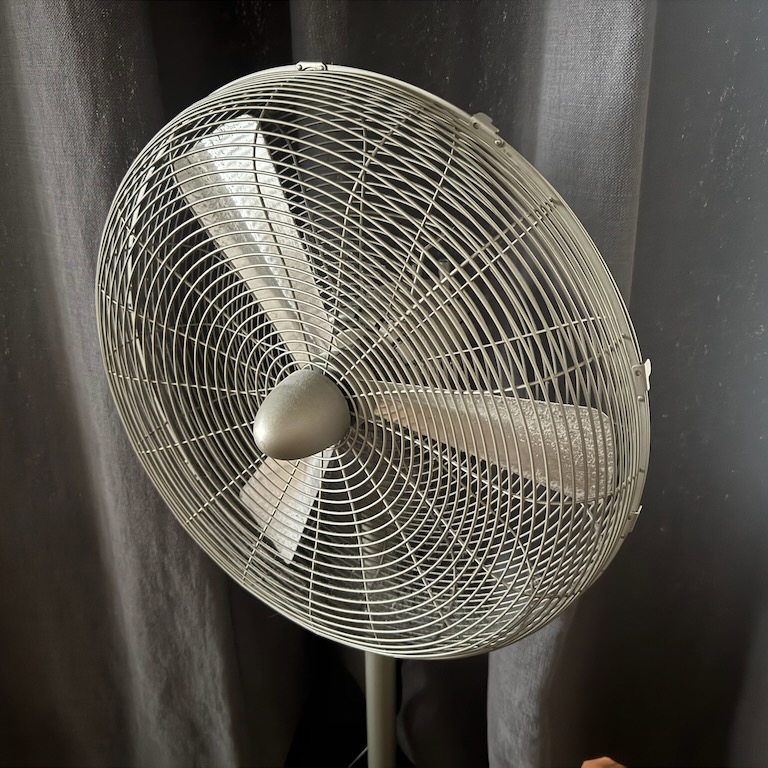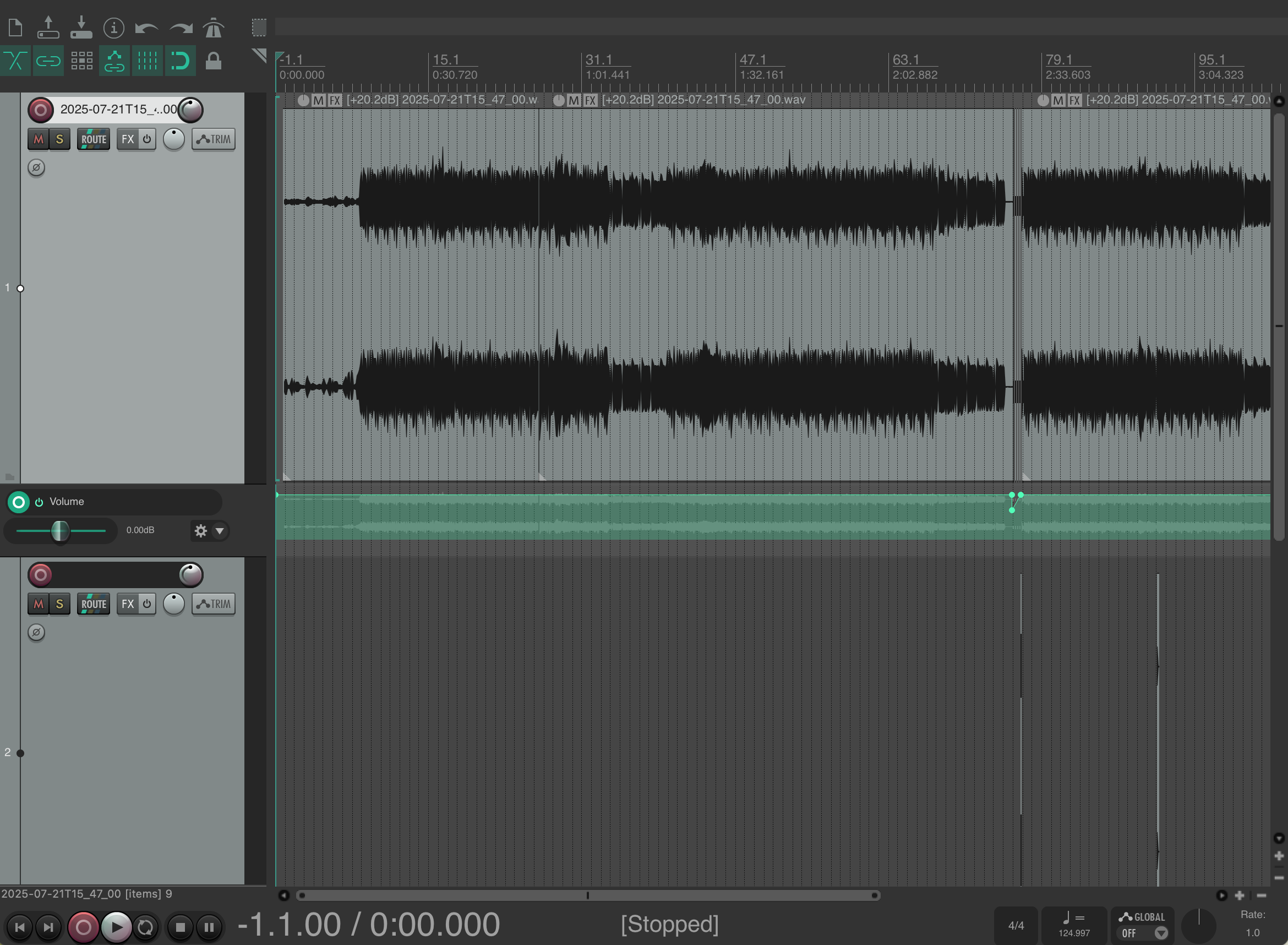2025-08-07
I have been learning new things about how I can use samplers and audio editing in my music.
Samplers
The sonic texture of samplers is all over some of the music that I love (example, example). There are many many creative uses for samplers in music but the ones I'm thinking of here are mainly the use of found objects and the sound of audio played back at the wrong speed. For example in 505 Fan I use the sound of a ventilator I recorded (a found object) played back at a higher speed to create a melodic voice.
 The fan in 505 Fan.
The fan in 505 Fan.
In addition to new textures, using my sampler gives me more music production options. For example I can use the same synth multiple times in the same song by sampling different sounds out of it. Or I take a drum machine with limited mixing possibilities, sample its sounds and run them through my main mixer with separate equalizer settings, panning, effect sends, subtle pitch changes, etc. Things that don't scream "this is a sampler" at the listener but that I could not have done without one.
Another side effect of my journey into sampling has been to listen more critically to timing. Partly due to lack of confidence about my playing and partly because I am used to the sound of it, I tend to 100% quantize all my music to the 16th note grid. But when I sample percussive sounds into the TX16W I am unable to get the transient right at the start of the sample, because the Typhoon OS insists on applying a fade-in. Fading in a drum hit ruins it so I'm forced to keep some leading silence. To make that work in my song I then have to nudge those percussive samples off the sequencer grid by ear. It works fine and I think it's actually a good thing to do this by ear and not by sight. So, I listen more closely and I occasionally leave the grid now.
Audio editing
As I have written before I have been exploring various ways to make music with sequencers but without a computer. There is no computer in my studio. That is still true but I have been learning how to make use of the computer to edit my studio recordings. This may sound like an obvious thing to do but I have been strongly opposed to it for 9 years so for me it is a big deal.
Up until now, if I wanted to edit my compositions I had to do it on the sequencer. This meant that I made songs where almost every sound was controlled by the sequencer. This works but it limits you to working with sounds that you can sequence. A lot of buttons, knobs and faders in my studio cannot be remote-controlled with MIDI. On top of that I observed that as I went on editing and refining, I would slowly get sick of the song and declare it finished when I could not bear to hear it one more time.
Then about 7 months ago I got heavily into live performance to bring more expression and spontaneity into my music (starting with Bim Dub). I really like this but it robbed me of the ability to edit. I would record a performance of myself pushing buttons and twisting knobs, hear some kind of mistake I didn't like in there, do another recording and make another mistake. I ended up recording many performances, never quite nailing it and slowly sucking the life and spontaneity out of the song, just in a different way.
What took me so long
I had already been asking around how other people deal with this and the answer was usually along the lines of "make a live recording and edit it on the computer afterwards". It has taken me a very long time to embrace this idea and put it into practice. Why is that?
One reason is wrong assumptions. Whenever I would see examples (in videos) of people using Digital Audio Workstation (DAW) software, I would see either multitrack recordings of live instruments (e.g. a rock band) or music that was composed on the computer (lots of little colored lego bricks on the timeline). I never saw someone working with a stereo audio file of a finished song that needed some editing.
 The Reaper editing session for the song 505 Fan. Mostly just one stereo track, with a few extra sound snippets (extracted from the main recording) sprinkled in on the second track.
The Reaper editing session for the song 505 Fan. Mostly just one stereo track, with a few extra sound snippets (extracted from the main recording) sprinkled in on the second track.
Even if I only use 2 tracks, it is still a good idea to use specialized audio editing software that is made for working on music.
Besides not seeing an example of what I needed, I also made wrong assumptions about what is and is not possible. I assumed that a stereo recording of a full mix would be impossible to edit because you would always be cutting off some instrument or a reverb tail that was sounding at the point where you made an edit, and that this would always sound bad. This is not true for several reasons. While you cannot make a cut wherever you want, there are often many places where you can. Crossfades go a long way towards smoothing things over. And if you cannot make an inaudible edit, you can create an audible edit (a transition) instead! I found this Sound on Sound article very enlightening.
What is particularly ironic here is that I have been wondering for a long time why there are sometimes little snippets of reversed audio in Aphex Twin songs that look like they were created by editing the audio after it was recorded. I now suspect some of those are transitions that hide an edit!
Finally I was lacking the right skills and not making enough of an effort to learn more. I find DAW software fussy and complicated. This kind of software has a learning curve. I tried learning Ableton Live and Apple Logic Pro but I never really got along with either of them. I am using Cockos Reaper now and crucially, I am making a bigger effort to learn how to use it.
Reaper
I don't always find Reaper pretty to look at but I am happy to be using it. Here are some of the things I like:
- Unlike Ableton or Logic, Reaper does not shove libraries full of loops and samples in my face.
- Reaper is very customizable. I can hide UI elements that I don't need so I don't have to look at them. This goes as far as giving the user the ability to remove the "Play" and "Stop" buttons.
- Reaper has a large amount of free video tutorials on its website. I find the voiceover distracting at times (strange pauses) but the presenter does a good job of clearly explaining how to do things.
I've been sporadically using Ableton and Logic for years now and 2 weeks into Reaper I am already more fluent than I ever got to be in the other two. Maybe if I would have found the right educational resource for Logic or Ableton I would be using either of them now, but now I am happy with Reaper.
Last night I recorded the second take of a song. I sat down afterwards to edit it, and again this afternoon. Now it's on Soundcloud: Quarter Edit. With my previous way of working I would never have finished something so quickly.
Conclusion
This is exciting. Who knows what I'll learn how to do next!
Tags: music